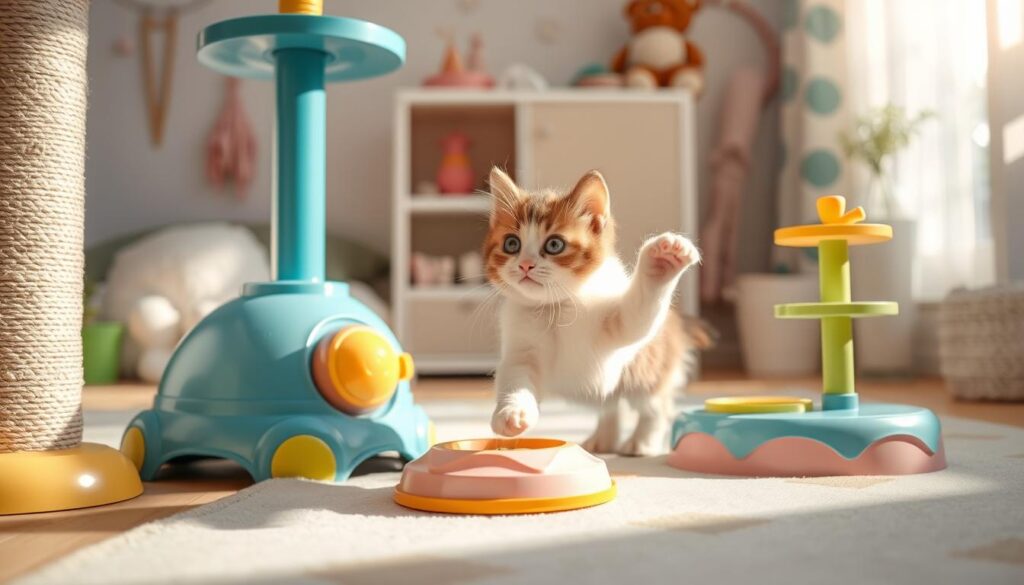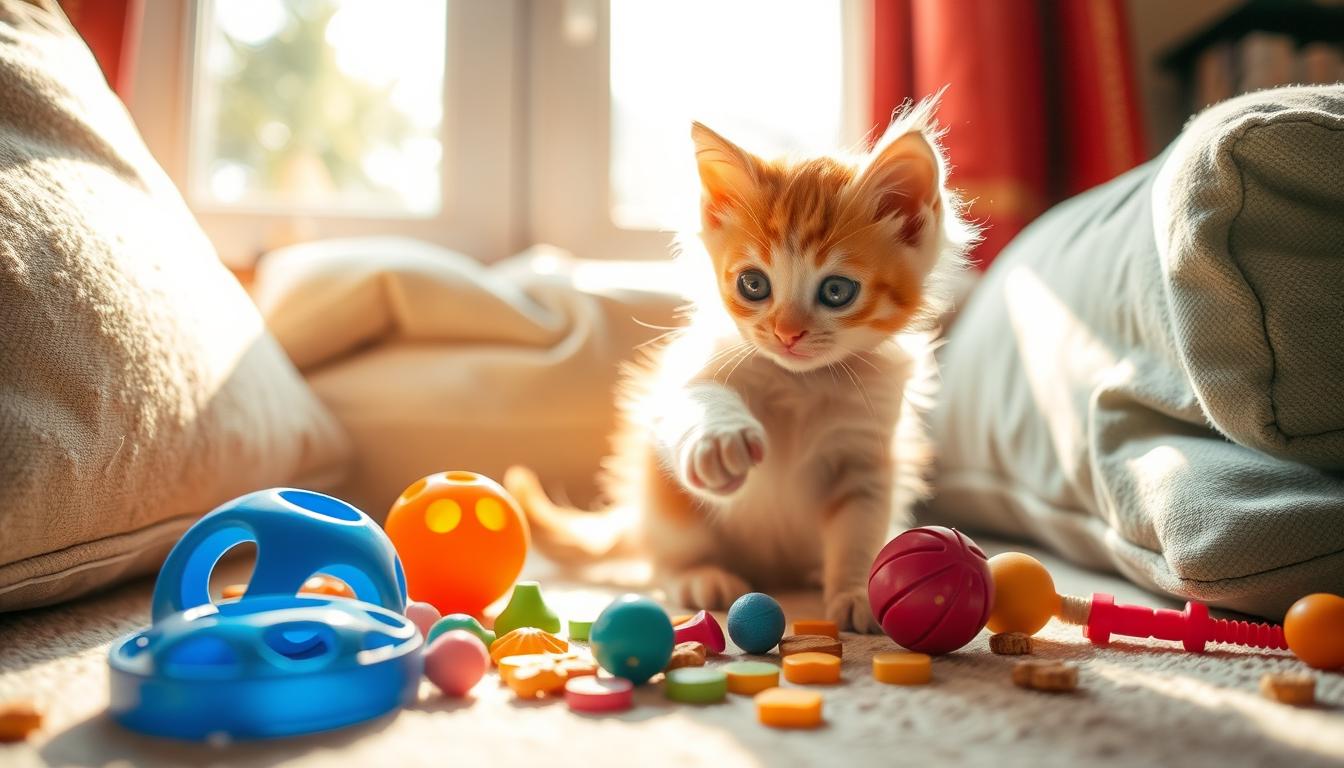As an Amazon Associate I earn from qualifying purchases.
The sound of tiny paws, endless curiosity, and cute antics make welcoming a kitten exciting. But, it also brings the duty of training your new friend. As someone who’s raised cats, I know kitten training is crucial. It helps your kitten grow into a well-behaved and emotionally balanced cat.
Kittens are naturally curious and open to learning. This is the best time to teach them good habits. With the right approach and patience, your kitten can become a well-trained and confident cat. This guide will cover the importance of kitten training, how to progress, and useful tips for your kitten’s growth.
The Importance of Training Your Kitten
Cats are surprisingly easy to train. Their smarts and hunting skills make them quick learners. The benefits of kitten training are huge. It helps you bond with your kitten and teaches them good habits.
Training your kitten can change their behavior for the better. They become more obedient and less likely to damage things. Kitten training teaches them to use a litter box, come when called, and play fetch. This makes your home a happier place.
“Positive reinforcement methods, such as rewarding good behavior with treats and affection, are the most effective way to train kittens. This approach helps build trust and encourages them to learn eagerly.”
Training your cat is more than just teaching tricks. It keeps their mind active and prevents boredom. Well-trained kittens are more confident and less likely to have behavioral issues later on.
Training your kitten is a great way to strengthen your bond. By spending time and patience on their education, you unlock their full potential. This makes them a well-adjusted and loving companion.
Kitten Training Levels and Progression
Training your kitten is a journey with different stages. From beginner kitten training to intermediate kitten training and advanced kitten training, each step is important. It helps your kitten learn and grow.
Beginner Level: Kitten Obedience Training
The beginner kitten training focuses on basic commands like “sit,” “stay,” and “come.” These commands are the foundation of good behavior. With patience and positive feedback, your kitten will learn these important skills.
Intermediate Level: Socialization Training
The intermediate kitten training level is about socialization. It’s when your kitten learns to interact with people, other animals, and their surroundings. This training makes your kitten well-adjusted and confident, ready for the next level.
Advanced Level: Teaching Tricks
At the advanced kitten training level, you can teach your kitten fun tricks. This level strengthens your bond and shows off your kitten’s skills. With effort and creativity, your kitten can learn a lot.

Remember, kitten training progression is a journey. Each stage is built on the last one. By understanding these stages of kitten training, you can help your kitten become a well-rounded, confident, and obedient friend.
Understanding Kitten Behavior and Training Strategies
Training your kitten is a rewarding journey that can strengthen your bond. Cats learn well through classical conditioning, a method from the 1900s by Ivan Pavlov. This method uses external stimuli to trigger automatic responses in your pet.
When training, your kitten needs to link actions with external cues like commands or sounds. Reward them with treats, praise, and gestures when they obey. Repeat this until they respond automatically to the cue. Never use negative reinforcements, as it can harm your cat or kitten.
“Cats can become bored without proper stimulation, leading to issues such as destructive behavior, weight gain, depression, and health problems. Training with cats can strengthen the bond between owners and their pets, improving understanding of the cat’s personality and building trust.”
Kittens have short attention spans, so keep training short, 3-5 minutes. Focus on one skill at a time. Consistency is crucial, so everyone in the household should use the same methods and cues. With patience and positive reinforcement, you can teach your kitten many commands and tricks.
Remember, cat behavior and training, feline psychology for training, and kitten psychology and learning are key. By using these principles, you can unlock your kitten’s full potential and enjoy a rewarding training experience.
How to Train Your Kitten
Training your kitten is key to being a good pet owner. Kittens learn best through classical conditioning, just like dogs. Your job is to teach them to link actions with sounds or gestures.
When your kitten does what you want, give them treats and praise. Do this many times until they do it on their own. Never use negative methods to train your cat or kitten. It can harm them. Hitting or yelling will only scare your kitten.
“Kittens respond better to positive reinforcement methods, such as using rewards and treats.”
Keep training sessions short, about 15 minutes. Clicker training helps cats learn faster, especially in shelters. Teach one thing at a time to keep your kitten focused.

Consistency is crucial in training your kitten. Always use the same signals for good behavior. Train after naps or before meals when they’re most alert. With these kitten training techniques, your kitten will grow into a well-behaved friend.
Intermediate Socialization Training
Now that your kitten knows the basics, it’s time to teach them to get along with people and other pets. Socializing kittens is key for their growth. It makes them feel at ease and confident in different places. By teaching them to love human affection, you’re preparing them for a happy life.
Help your kitten feel comfortable around people by cuddling and sitting on your lap. Give them treats and praise when they do. Some kittens, like Ragdolls and Siamese, love to cuddle. Others, like British Shorthairs, might need more practice.
Teach your kitten to shake hands or fist-bump. These fun actions help them get used to human touch. They also prepare your kitten for vet visits and grooming, keeping them calm and cooperative.
Socializing kittens takes time, and each one learns at their own pace. Be patient and use positive rewards. With patience and practice, your kitten will become a friendly and adaptable companion.
Advanced Trick Training
Advanced trick training is fun and rewarding for you and your kitten. If your kitten knows basic obedience and socialization, you can teach them fun kitten training tricks. These tricks keep them mentally and physically active.
Clicker training is a great method for advanced tricks. It uses a device that makes a clicking sound to mark the exact moment your kitten does something right. This makes it easier for them to learn tricks like high-fiving or sitting on command.
Teaching your kitten to shake hands or do fist-bumps is a great way to bond. By extending your hand and using a command, your kitten can learn these tricks. They’ll get treats or affection when they do it right.
As your kitten gets better at these tricks, you can teach them even more. They can learn to walk on a leash, ring a bell, or even use a human toilet. Start simple, be consistent, and always celebrate their successes.
Remember, teaching kittens tricks is optional but fun. It keeps your kitten engaged, mentally sharp, and close to you. Enjoy finding out what your kitten can do and making memories together.
Addressing Undesirable Behaviors
As your kitten grows, you might see behaviors like scratching furniture or biting and kicking. These are natural for cats. You can guide them away from these actions with the right steps.
Scratching Furniture
Scratching is how cats keep their claws healthy. Give your kitten proper scratching posts, cardboard, or cat trees to do this. If they scratch furniture, gently move them to the right spots. Praise or treats will help them learn.
Biting or Kicking
Kittens are playful and combative. But, never let them attack you. If they bite or kick, walk away without yelling. This teaches them that bad behavior means no playtime.
With patience and consistency, you can stop these behavioral issues. Positive reinforcement is crucial for kitten discipline. It helps your kitten become a well-adjusted, happy friend.
Training Essentials and Tips
Effective kitten training is about making it a positive experience for your kitten. It’s important to focus on your kitten’s well-being, use the right rewards, and practice consistently.
Always try to make training stress-free for your kitten. Use their favorite treats and cat food as rewards. Choose a quiet place for training and keep sessions short, under 15 minutes.
Using the same signals or cues is key for your kitten to learn. Positive rewards work better than punishment. Learning takes time, so be patient and keep practicing. With the right kitten training essentials and best practices, you’ll bond with your kitten and keep them mentally and physically active.
“Training your kitten can be a rewarding experience, but it’s important to remember that it’s a journey. Consistency, patience, and positive reinforcement are the keys to effective kitten training.”
By following these kitten training dos and don’ts, you’ll help your kitten reach their full potential. Enjoy the journey of training your kitten to be a well-behaved and happy friend.
Conclusion
In this guide, we’ve talked about why training your kitten is key. We covered different training levels, effective methods, and how to handle common issues. By following these tips, you can communicate well with your kitten, stop bad behaviors, and build a strong bond.
Be patient, use positive methods, and make training fun for both you and your kitten. With consistent effort, you’ll have a well-trained cat that brings you joy. The key takeaways on training kittens include short sessions, timing them with meals, and focusing on one skill at a time.
Starting to train your kitten is exciting, even with challenges. The summary of kitten training guide stresses understanding your kitten’s behavior, using positive methods, and tailoring training to their needs. With these tips, you’re on your way to raising a confident, well-behaved cat that will bring joy and laughter to your life for years.
As an Amazon Associate I earn from qualifying purchases.

